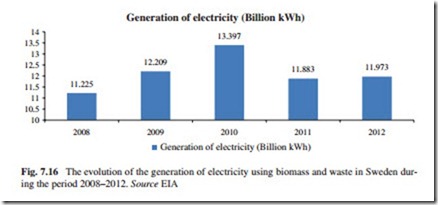Sweden
Sweden is one of the countries in the world that has become the furthest on the road toward fossil fuel independence. Renewable energy has played a major role in Sweden’s push to become independent from fossil fuels. In 2005, Sweden’s government set a target of producing 50 % of its energy from renewable sources by 2020 and achieving complete carbon neutrality by 2050. Currently, Sweden produces 45 % of its energy from renewable energy sources. It supplies almost all its electricity from nuclear and hydroelectric power, but is increasingly moving toward biomass and waste energy. Thus far, Sweden has been extraordinar- ily successful in weaning itself off of oil. In 1970, oil accounted for over 75 % of Swedish energy supply. By 2009, the figure was just 32 %, chiefly due to the declining use of residential heating oil. Sweden also substantially decreased its coal consumption. Peaking at over 5 trillion tons of coal consumed in 1986, it now consumes a third of that at 1.8 trillion tons.
The overall objectives set out in the new energy and climate policy adopted by the government are as follows:
• To ensure a reliable supply of electricity and other energy;
• To create favorable conditions for efficient use of energy and a cost-efficient supply of energy focusing on a low negative impact on health, the environment, and climate;
• To promote the transformation to an ecologically sustained society.
For several of these overall objectives, it will be important to increase the pro- portion of renewable energy, to improve energy efficiency, to reduce the use of energy in absolute terms, and to reduce emissions. One general means of achieving energy policy objectives, and which is intended to help to meet several of the objectives, is energy taxation, in the form of energy taxes, carbon dioxide tax, and sulfur tax.
The total energy consumption generated from biomass in Sweden grew from 88 to 115 TWh between 2000 and 2009, while the usage of oil-based products declined from 142 to 112 TWh during the same period, according to the Swedish Bioenergy Association SVEBIO. In 2010, the generation of energy from biomass and waste (bioenergy) reached 128.7 TWh or 32 % of the total energy generated in the country.
It is important to highlight that in Sweden in 2009 biomass surpassed oil to become the number one source for energy generation and that the majority of Sweden’s energy supply is for the purpose of electricity generation, district heat- ing, and fuel transportation. Renewable resources contributed more than 10 % of Sweden’s electricity supply as of 2011. Sweden’s abundant forest resources make biomass feedstock the largest renewable energy source as 60 % of Sweden
is covered in forests, and woody biomass, including timber residual feedstock. The Swedish government has committed itself to a more ambitious 50 % target for 2020 under the Renewable Energy Directive (Government Offices of Sweden 2006).
Generation of Electricity Using Biomass and Waste
The evolution of the generation of electricity using biomass and waste in Sweden during the period 2008–2012 is shown in Fig. 7.16.
According to Fig. 7.16, the generation of electricity using biomass and waste in Sweden during the period 2008–2012 increased 6.7 %. During the period 2008– 2010, the use of this type of energy source for the generation of electricity in the country increased significantly (24.2 %), but after 2010, the use of biomass and waste decreased (11 %). However, it is expected that the use of biomass and waste for the generation of electricity in Sweden will increase during the coming years, particularly after the reduction in the participation of nuclear energy in the generation of electricity foreseeable for the coming years. The planned additional elec- tricity generation from biomass up to 2016 adopted by the government is 2.9 TWh per year.
